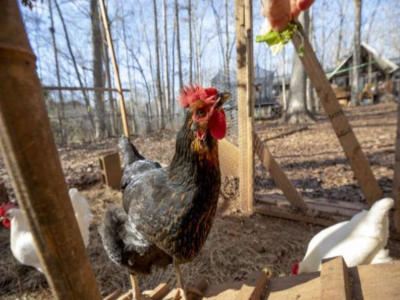By Allyson Mann
Keeping backyard chickens was already on the rise, and the hobby has become even more popular during the COVID-19 pandemic. Now, a University of Georgia researcher cautions that the practice has risks not just for chickens, but for wildlife and people as well.
"As a researcher who studies pathogen movement along different groups, I see backyard chickens as a potential interface where pathogens can spill over into wild birds, or vice versa, and even into people," said Sonia Hernandez, professor of wildlife disease at the Warnell School of Forestry and Natural Resources and the College of Veterinary Medicine. "Owners need to seek information and medical care for their animals to minimize those risks."
Hernandez and first author Andrea Ayala published their comprehensive review of pathogen transmission at the backyard chicken-wild bird interface in Frontiers in Veterinary Science. Ayala, now a postdoctoral researcher at Yale University, earned a Ph.D. in the College of Veterinary Medicine's Comparative Biomedical Sciences program.
The most well-known pathogen carried by chickens is salmonella, and almost everyone is aware of it, said Hernandez. That's due to public education and outreach efforts by the Centers for Disease Control and Prevention and public health agencies.
Food is the source for most of the estimated 1.35 million salmonella infections in people every year in the United States, according to the CDC. Most people who get ill from salmonella experience diarrhea, fever and stomach cramps, but there are 26,500 hospitalizations and 420 deaths every year.
"They're trying to stay on top of salmonella in backyard chickens because they have seen an explosion of salmonellosis in people as a result of this recent popularity of keeping chickens," she said. "It can become especially dangerous if you mix little chickens with little people—young chickens that are shedding a lot of salmonella with small kids that don't have the best hygiene practices."
How to reduce risks
Ayala identified a number of practices that backyard chicken owners can implement to reduce the risk of pathogen emergence:
- keeping backyard chicken feeders where only chickens can reach them
- getting rid of wild bird feeders
- using mesh small enough to prevent wild birds from interacting with chickens
- removing contaminated water sources, insects and rodents; maintaining good hygiene—changing footwear, for example—when visiting different flocks
- limiting the number of visitors
